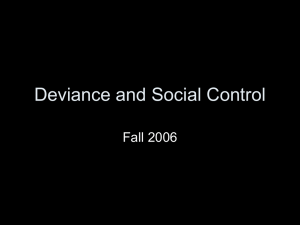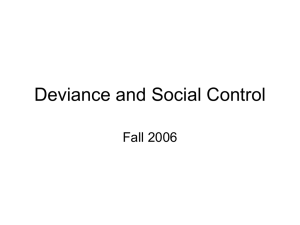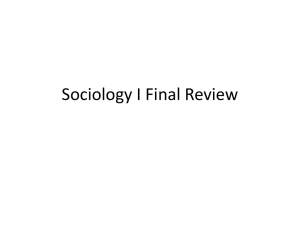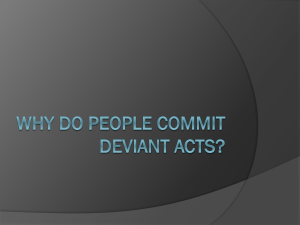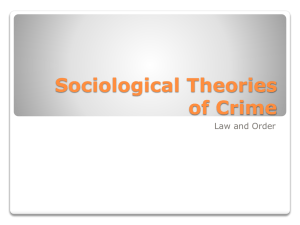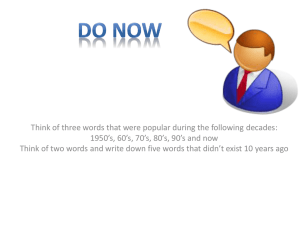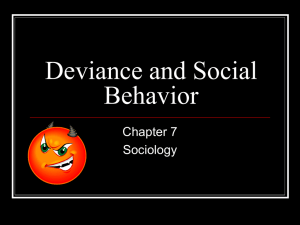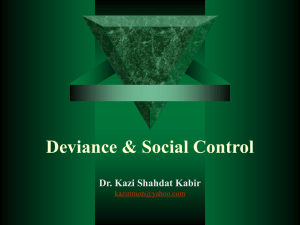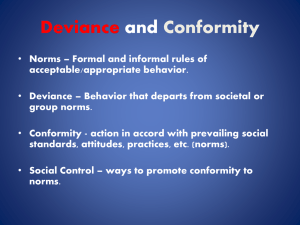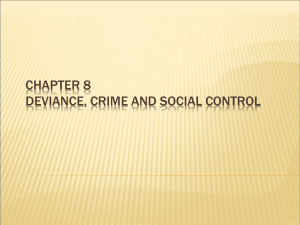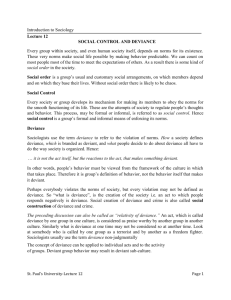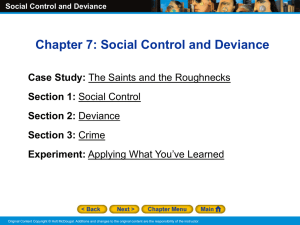Ch. 6 PowerPoint - SteveBailes.org
advertisement
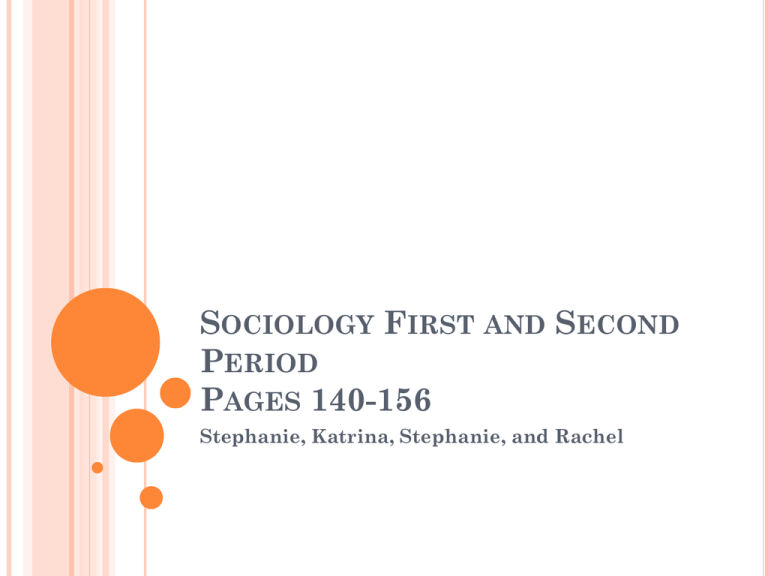
SOCIOLOGY FIRST AND SECOND PERIOD PAGES 140-156 Stephanie, Katrina, Stephanie, and Rachel WHAT IS DEVIANCE? • • • • • • Howard S. Becker (1966) To refer to any violation of norms. Howard Becker described this way “it is not the act itself, but the reactions to the act, that make something deviant. What deviant to some is not deviant to others. Its held within society and through out cultures. Relativity of deviance a major point made by symbolic interactionists. WHAT IS STIGMA? • • • • Erving Goffman (1963) To refer to characteristics that discredit people. Violations of norms include ability, appearance, and norms of involuntary membership. Stigma can become a persons master status. HOW NORMS CAN MAKE SOCIAL LIFE POSSIBLE • • • • No human group can exist without norms for norms make social life possible by making behavior predictable. Without norms we would have social chaos. A groups customary social arrangements are called social order. Deviance undermines, predictability of social life. SANCTIONS • • • Expressions of disapproval of deviance is called negative sanctions. Most negative sanctions are informal. Positive sanctions are use to reward people for conforming to norms. COMPETING EXPLANATIONS OF DEVIANCE—SOCIOBIOLOGY • • • Sociobiology explains deviance by looking for answers within individuals. They assume that genetic predispositions lead people to such deviances. There's three theories: 1. 2. 3. Intelligence- if low turns to crime. “XYY” theory-an extra Y chromosome in males leads to crime Body type-people with “squarish muscular” bodies are more likely to commit street crime. COMPETING EXPLANATIONS OF DEVIANCE—PSYCHOLOGISTS • • • • They focus on abnormalities within the individual. They examine personality disorders. Deviating individuals have deviating personalities and that subconscious motives drive people to deviance. Deviance is not associated with any particular personality. COMPETING EXPLANATIONS OF DEVIANCE—SOCIOLOGISTS • • • They search for factors outside the individuals. They look for social influences that “recruit” people to break norms. They examine such external influences as socialization membership in subcultures, and social class. SYMBOLIC INTERACTIONIST PERSPECTIVE • Basic principle of symbolic interactionism is this: We act according to our interpretation of situations, not according to blind predisposition. DIFFERENTIAL ASSOCIATION THEORY • • • • • • • • Sociologists stress that people learn deviance. Edwin Sutherland coined the term differential association to indicate that we learn to deviate from or conform to society's norms primarily from the different groups we associate with. What we learn influences us toward or away from deviance. Different groups send us mixed messages that result in an imbalance. Your family helps lead you away from deviance. Symbolic interactionists stress that we are not mere pawns in the hands of others. Ex: Member’s of the Mafia also intertwine ideas of manliness with violence. “To kill is a measure of their manhood.” CONTROL THEORY • • • • • • • Walter Reckless (1973) He developed the control theory which stresses that two control systems work against our motivations to deviate. Our inner controls include our internalized morality, and our outer controls consists of people. The stronger our bonds are with society, the more effective our inner controls are. Bonds are based on attachments, commitments, involvements, and beliefs. This theory can be summarized as self-control (Travis Hirschi) Key to learning high self-control is socialization. LABELING THEORY • • Our “reputations” also called labeling theory is developed from our social interaction. Sociologists Greshman Sykes and David Matza found people use five techniques of neutralization to deflect society’s norms. 1.Denial of Responsibility 2. Denial of Injury 3.Denial of a Victim 4. Condemnation of the Condemners 5. Appeal to Higher Loyalties LABELING THEORY • • Although most of us resist others’ attempts to label us as deviant, there are those who revel in a deviant identity. Sociologist Mark Watson did participant observation with outlaw bikers that statuses among fellow members of a subculture is more important that any statuses outside it. LABELING THEORY • • • William Chambliss concluded that the split vision between the roughnecks and the saints was due to social class. Social class vitally affects our perceptions and behavior. Labels open and close doors of opportunity. FUNCTIONALIST PERSPECTIVE • • Emile Durkheim concluded deviance is functional for society. 1.Deviance clarifies moral boundaries and affirms norms. 2.Deviance promotes social unity. 3.Deviance promotes social change. Richard Cloward and Lloyd Ohlin identified the crucial problem of the industrialized world— the need to locate and train the most talented people of every generation. FUNCTIONALIST PERSPECTIVE • Robert Merton developed the strain theory—people who experience strain are likely to feel a sense of normlessness. 1. Conformity– to reach cultural goods. 2. Innovators– who accept the goals of society but use illegitimate to reach them. 3. Ritualism– cling to conventional rules of conduct. 4.Retreatism– reject the cultural goals and the institutionalized means of achieving them. 5. Rebellion– reject both society’s goals and its institutionalized means yet seek to give society new goals. ILLEGITIMATE OPPORTUNITY STRUCTURE • • • • Richard Cloward and Lloyd Ohlin said that different doors that open to the poor are called illegitimate opportunity structures. White-Collar Crime refers to crimes that people of respectable and high social status commit in the course of their job. Corporate Crime are a special form of whitecollar crime that is committed by executives to benefit their corporation. A major change in the nature of crime is the growing number of female offenders. The basic reason for this is women’s changed social locations.


